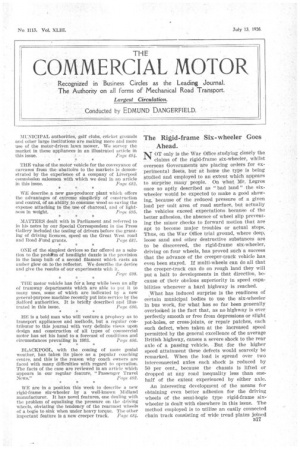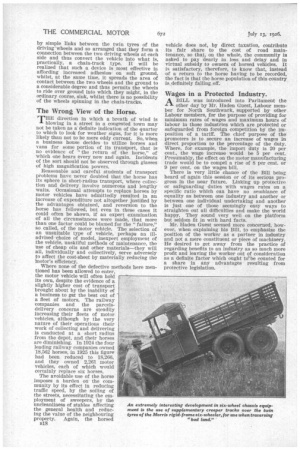The Rigid-frame Six-wheeler Goes Ahead.
Page 1

Page 2

If you've noticed an error in this article please click here to report it so we can fix it.
OT only is the War Office studying closely the claims of the rigid-frame six-wheeler, whilst overseas Governments are placing orders for experimental fleets, but at holne the type is being studied and employed to an extent which appears to surprise many. people. On what Mr. Legros once so aptly described as "bad land" the sixwheeler would be expected to make a good showing, because of the reduced pressure of a given load per unit area of road surface, but actually the vehicles exceed expectations because of the better adhesion, the absence of wheel slip preventing the minor checks to forward motion that are apt to become major troubles or actual stops. Thus, on the War Office trial ground, where deep, loose sand and other destructive substances are to be discovered, the rigid-frame six-wheeler, driving on four wheels, has proved such a success that the advance of the creeper-track vehicle has even been stayed. If multi-wheels can do all that the creeper-track can do on rough land they will put a halt to developments in that direction, because of their obvrous superiority in speed capabilities whenever a hard highway is reached.
What has induced surprise is the readiness of certain municipal bodies to use the six-wheeler In bus work, for what has so far been generally overlooked is the fact that, as no highway is ever perfectly smooth or free from depressions or slight pot-holes, or cross-joints, or repair patches, each such defect, when taken at the increased speed permitted by the general excellence of the average British highway, causes a severe shock to the rear axle of a passing vehicle. But for the higher speed attainment these defects would scarcely be remarked. When the load is spread over two interconnected axles each shock is reduced by 50 per cent., because the chassis is lifted or dropped at any road inequality less than onehalf of the extent experienced by either axle.
An interesting development of the means for obtaining even better adhesion for the driving wheels of the semi-bogie type rigid-frame sixwheeler is dealt with elsewhere in this issue. The method employed is to utilize an easily connected chain track consisting of wide tread plates joined by simple links between the twin tyres of the driving wheelsand so arranged that they form a connection between the two driving wheels at each side and thus convert the vehicle into what is, practically, a chain-track type. It will be realized that such a device is , most effective in affording increased adhesion on soft ground, whilst, at the same time, it spreads the area of contact between the two wheels and the ground to a considerable degree and thus permits the wheels to ride over ground into which they might, in the ordinary course, sink, whilst there is no possibility of the wheels spinning in the chain-tracks.
The Wrong View of the Horse. rir
HE direction in which a breath of wind is -R. blowing in a street in a congested town may not be taken as a definite indication of the quarter to which to look for weather signs, for it is more likely than not to be mere eddy current. So, whell a business house decides to utilize horses and vans for some portion of its transport, that is no evidence of the return of the horse," of which one hears every now and again. Incidents of the sort should not be observed through glasses of high magnification powers.
Reasonable and careful students of transport problems have never doubted that the horse has its sphere in short-radius transport, where collec: tion and delivery involve numerous and lengthy waits. Occasional attempts to replace horses by motor vehicles have admittedly resulted in an increase of expenditure not altogether justified by the advantages obtained, and reversion to the horse has followed, but even in these eases it could often be shown, if an expert examination of all the circumstances were made, that more than one factor could be blamed for the " failure," so called, of the motor vehicle. The selection of an unsuitable type of vehicle, perhaps an illadvised choice of model, inexpert employment of the vehicle, unskilful methods of maintenance, the use of cheap oils and other materials—they will all, individually and collectively, serve adversely to affect the cost-sheet by materially reducing the Motor's efficiency.
Where none of the defective methods here mentioned has been allowed to enter, the motor vehicle will often hold its own, despite the evidence of a slightly higher cost of transport brought about by the inability of a business to get the best out of a fleet of motors. The railway companies and the parcelsdelivery concerns are steadily increasing their fleets of motor vehicles, although by the very nature of their operations their work of collecting and delivering is conducted at a short radius from the depot, and their horses are diminishing. In 1924 the four leading railway companies owned 18,562 horses, in 1925 this figure had been reduced to 18,266, and they owned 2,261 motor vehicles, each of which would certainly replace six horses.
The avoidable use of the horse Imposes a burden on the community by its effect in reducing traffic speed, by the soiling of the streets, necessitating the employment of sweepers, by the uncleanliness of stables affecting the general health and reducing the value of the neighbouring property. Again, the horsed 1318 vehicle does not, by direct taxation, contribute Its fair share to the cost of road maintenance, so that, on the whole, the community is asked to pay dearly in loss and delay and in virtual subsidy to owners of horsed vehicles. It is satisfactory, therefore, to know that, instead of a return to the horse having to be recorded, the fact is that the horse population of this country is. definitely falling off.
Wages in a Protected Industry.
ABILL was introduced into Parliament the other day by Mr. Haden Guest, Labour member for North Southwark, supported by other Labour members, for the purpose of providing for minimum rates of wages and maximum hours of labour in those industries which are protected or safeguarded from foreign competition by the imposition of a tariff. The chief purpose of the promoters is to secure an increase of wages in direct proportion to the percentage of the duty. Where, for example, the import duty is 20 per cent., the wage increase would be 5 per cent. Presumably, the effect on the motor manufacturing trade would be to compel a rise of 8 per cent. or 9 per cent. on the wages bill.
There is very little chance of the Bill being heard of again this session or of its serious progress in the near future. Linking up protective or safeguarding duties with wages rates on a specific ratio which can have no semblance of equality as between one industry and another or between one individual undertaking and another is just one of those seemingly easy ways to straighten out all difficulties and make the world happy. They sound very well on the platform but seldom fit in with hard facts.
Mr. Haden Guest seemed more concerned, however, when explaining his Bill, to emphasize the position of the worker as a partner in industry and not a mere constituent or piece of machinery. He desired to get away from the practice of regarding benefits to an industry as so much more profit and leaving the worker out of consideration as a definite factor which ought tolbe counted for a share in any advantages resulting from protective legislation.






























